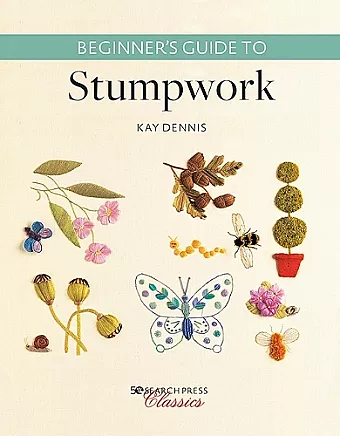Beginner’s Guide to Stumpwork
Format:Paperback
Publisher:Search Press Ltd
Published:12th Mar '20
Should be back in stock very soon

Kay Dennis is passionate about Stumpwork. This intricate, raised and padded embroidery has its origins in the 17th century, and is enjoying a revival amongst embroiderers and lacemakers. It is wonderfully versatile and will appeal both to the novice and needleworker. Using a mix of flat, padded, wired and free-standing elements, it employs a wide range of embroidery techniques. This comprehensive and colourful book covers both basic and needle lace techniques – sections on each contain a series of elaborate step-by-step demonstrations showing how to work individual techniques, followed by a project combining all the methods. Kay takes inspiration from a variety of sources and her designs include animals, flowers, fruits and insects – popular motifs in the 17th century. She also creates contemporary designs and there are advanced projects on landscape and figurative work. A gallery of Kay's work is included to inspire the reader.
Search Press is celebrating 50 years in print and has reissued selected titles from their back list. Each of these is considered a classic of its kind, and this book, Stumpwork for Beginners from 2001, has been selected for republication.
Stumpwork is often considered one of the more advanced forms of embroidery and was the culmination of years of learning other styles and working samplers for young ladies in the 16th and 17th centuries. This padded, raised form of embroidery was mounted onto caskets and cabinets and gets its name from the carved pieces of wood used as bases for faces and other 3D features.
This book shows the beginner what to buy and which stitches you need to make a start. A wide range of threads can be used and most if not all the other tools and materials are common to other styles of needlework. You don’t need any wood carving skills either, just toy filling to pad out shapes you want to raise. Some books on stumpwork emulate the style associated with the original pieces but this book has updated it and taken inspiration largely from nature.
There are no chapters concerned with learning stitch by stitch, but you jump right in with a sampler of several elements which teaches you the basics. Make and prepare padding, learn stitches such as turkey knot and spider’s web and then progress to needlelace. Find out how to make heads and hands, and then bring it all together in a picture of a gardener tending a garden full of fruit and flowers.
The elements and pictures include toadstools, a seaside scene, fish in the seaweed, poppy heads, topiary with a polymer clay pot and a butterfly. All are ideal for mounting on boxes of your own and it is easy to see why this book was selected for classic status: it helps to explode the myth that stumpwork is a mysterious, complex style suited only for very advanced embroiderers. The author claims that even a total beginner to all forms of embroidery could tackle these projects and although it is possible I think that the book is more aimed at those who are au fait with some other needlework styles and want to try something different.
If you cannot find a good range of embroidery and needlecraft materials locally try http://www.searchpress.com for a list of suppliers.
-- Rachel Hyde * myshelf.cISBN: 9781782217909
Dimensions: 260mm x 204mm x 6mm
Weight: 306g
80 pages